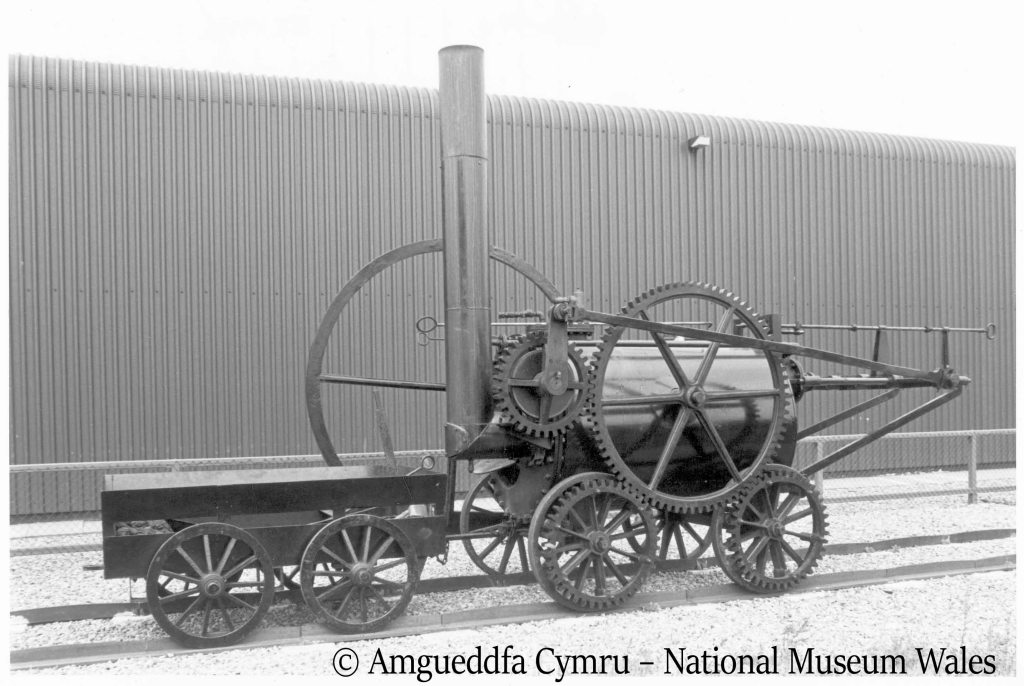
On 21 February 1804, the world’s first ever railway journey ran 9 miles from the ironworks at Penydarren to the Merthyr-Cardiff Canal, South Wales. It was to be several years before steam locomotion became commercially viable and hence the claim that Richard Trevithick and not George Stephenson was the real father of the railways.
In 1802, Homfray commissioned engineer Richard Trevithick to build built one of his high-pressure steam engines to drive a hammer at the Penydarren Ironworks. With the assistance of works engineer Rees Jones, Trevithick mounted the engine on wheels and turned it into a locomotive. In 1803, Trevithick sold the patents for his locomotives to Homfray.
In 1803, Samuel Homfray brought Richard Trevithick to his Penydarren ironworks at Merthyr Tydfil in South Wales. Homfray was interested in the high pressure engines that the Cornishman had developed and installed in his road engines.
He encouraged Trevithick to look into the possibility of converting such an engine into a rail-mounted locomotive to travel over the newly laid tramroad from Penydarren to the canal wharf at Abercynon.
It would appear that Trevithick started work on the locomotive in the autumn of 1803 and, by February 1804, it was completed. Tradition has it that Richard Crawshay, owner of the nearby Cyfarthfa ironworks, was highly sceptical about the new engine, and he and Homfray placed a wager of 500 guineas each with Richard Hill (of the Plymouth ironworks) as to whether or not the engine could haul ten tons of iron to Abercynon, and haul the empty wagons back.
The first run was on 21 February 1804, and was described in some detail by Trevithick:
“…yesterday we proceeded on our journey with the engine, and we carried ten tons of iron in five wagons, and seventy men riding on them the whole of the journey… the engine, while working, went nearly five miles an hour; there was no water put into the boiler from the time we started until our journey’s end… the coal consumed was two hundredweight”.
Unfortunately, on the return journey a bolt sheared, causing the boiler to leak. The fire then had to be dropped and the engine did not get back to Penydarren until the following day.
This gave Crawshay reason to claim that the run had not been completed as stipulated in the wager, but it is not known if this was ever settled!
The engine was, in fact, too heavy for the rails. Later, it would serve as a stationary engine driving a forge hammer at the Penydarren works.
Replica locomotive
The replica locomotive on display in the National Museum of Wales was built working from Trevithick’s original documents and plans (now in the National Museum of Science and Industry). It was inaugurated in 1981 and, ironically, presented the exact same problem as the original engine — it too broke the rails on which it ran!
This locomotive was displayed and demonstrated at the Welsh Industrial and Maritime Museum at Cardiff from 1981 until the museum closed in 1998.
From 1998 to the start of 2005 it was loaned for display at the National Railway Museum at York.
In the early months of 2004 to mark the bicentenary of the first recorded steam locomotive journey on a railway in February 1804, it was loaned to Merthyr Tydfil County Borough Council for display at Merthyr Tydfil.
After its return to York in mid 2004 it was returned to steam for the National Railway Museum’s Railfest in summer 2004.
From 2005 to the present it has been displayed and demonstrated at the National Waterfront Museum at Swansea, which is also part of the National Museum of Wales.

